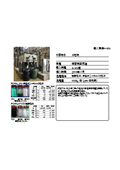Case Study of Introducing a Decompression Dehydration Drying Device: Precision Equipment Manufacturer
Compact and energy-efficient! Introduction of case studies for vacuum dehydration drying equipment.
We would like to introduce a case study of the introduction of the vacuum dehydration drying device "G300 model" to a precision machinery manufacturing company. For about 20 years, they had been using evaporation concentration equipment from other companies, but due to aging, they considered updating their equipment. It was recognized for being compact and energy-efficient compared to conventional devices, leading to its adoption. 【Case Overview】 ■ Introduction Date: November 2019 ■ Waste Liquid Processed: Degreasing waste liquid, Electroless nickel plating waste liquid ■ Processing Volume: 6600L/day (operating 24 hours/day) ■ Volume Reduction Rate ・Electroless nickel plating waste liquid: 87.05% ・Degreasing waste liquid: 96.69% *For more details, please refer to the PDF document or feel free to contact us.
Inquire About This Product
basic information
For more details, please refer to the PDF document or feel free to contact us.
Price range
Delivery Time
Applications/Examples of results
For more details, please refer to the PDF document or feel free to contact us.
catalog(1)
Download All CatalogsCompany information
Our company is developing as an environmental conservation equipment manufacturer by applying the core technology of dry cleaning machine development and its elemental technologies (gas recovery using activated carbon, reuse through solvent distillation regeneration) to other industries. This has resulted in the removal treatment of low-concentration radioactive contaminated materials and the cleanliness management process for final cleaning systems of space-related engines. We propose the distillation concentration of high-concentration waste liquid discharged from production processes using a vacuum dehydration drying device based on vacuum distillation, contributing to the reduction of industrial waste, resource recovery, and the reuse of distilled water.








